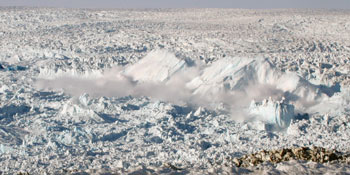Iceberg calving 2.0:
An energy source for ocean waves, seismic waves, and turbulence
By:
Jason Amundson
Postdoctoral Scholar
Dept. of Geophysical Sciences
University of Chicago
| When: | Friday, April 15, 2011, 10:30 a.m. to 11:30 a.m. Join us for coffee beginning at 10:00 a.m. |
| Where: | Seminar Conference Room, 10100 Burnet Road, Bldg 196-ROC, Austin, Texas 78758 |
| Host: | Ginny Catania, UTIG |

Abstract
Iceberg calving has long been recognized as an important component of glacier mass balance because it accounts for a large portion of the mass loss and strongly influences the dynamics of marine-terminating glaciers. Traditionally, most studies have treated calving from this purely glaciological viewpoint.
Recent timelapse, satellite, and seismic observations, however, have given awareness and appreciation for the importance of energy released during calving events (especially those involving icebergs that capsize). By releasing large amounts of energy, calving icebergs (1) transmit information, in the form of ocean and seismic wave energy, that can be used to investigate the processes controlling calving and (2) interact with the proglacial environment by generating ocean waves and turbulence and by perturbing sea ice and previously-calved icebergs.
In this talk I will provide motivation for this new "energy balance perspective" of calving and provide preliminary results from our attempts to understand iceberg calving energetics.




